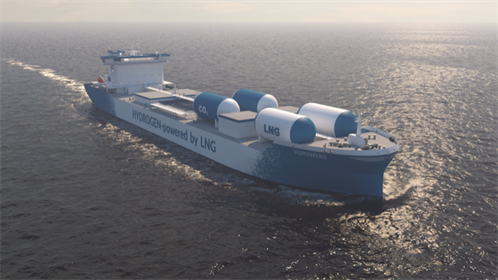RINA approves first MR tanker to exceed IMO 2050 targets
RINA has announced the approval in principle (AiP) of Swedish designer FKAB Marine Design’s hydrogen powered MR tanker, the first AiP of a design using currently viable technology and fuels that achieves IMO 2050 targets. Conceived by the class society and designed by FKAB, the propulsion is based on combining the ship’s fuel (LNG) with steam to produce hydrogen and CO2. The MR LNG/hydrogen-fueled vessel is the result of a joint project with ABB and Helbio (a subsidiary of Metacon AB).

Antonios Trakakis, Greece Marine Technical Director at RINA, said, “To meet CO2 reduction targets, shipping is faced with the challenge of having solutions which either rely on fossil fuels, but which still require technology to mature, or on new, zero carbon fuels, the availability of which is still far from being guaranteed. This new design enables the use of hydrogen as a fuel today without the need for bunkering and storage on board and exceeds IMO 2050 targets for 70% reduction of carbon intensity.”
The MR tanker design is based on combining LNG with steam in a Helbio gas reformer to split LNG molecules into hydrogen and CO2. Hydrogen is then directly used to fuel the internal combustion engines and fuel cells in a hybrid marine power system by ABB. The CO2 is captured by splitting the LNG molecules, rather than from exhaust gas.
Using this design, hydrogen usage can be progressively increased to maintain a top carbon intensity index (CII) rating throughout the life of the ship, reducing CO2 emissions in a parallel slope with the applicable regulations. The ship can meet full decarbonization targets by either running the engine on 100% hydrogen, or by producing all the power needed by fuel cells. In this way, the owner can decide the rate of CO2 reduction.
Carbon disposal will be a vital technology for the future to meet global decarbonization goals across all sectors. The concept will not require onshore carbon disposal technology to be available before 2032.
Andreas Hagberg, Head of Sales & Marketing Department at FKAB, commented, “The concept is revolutionary because it does not require any portside hydrogen infrastructure. The hydrogen is created onboard the vessel and all necessary equipment can be easily fitted on deck, so ship owners can convert existing vessels. The fuel cells have been specifically developed to produce more power and fewer emissions.”
CO2 is liquefied by the cryogenic steam from the LNG and can be used as the inert gas for the tanker. No additional bunkering, aside from normal LNG, is required. The hydrogen produced can be used to power the main engine, or fuel cells, or a hybrid of the two. The AiP covers the hybrid option.
Trakakis concluded, “Now that the concept has been brought to the real world through an immediately applicable CII A rated design, this opens the door to reduce emissions in a much shorter timeframe. The AiP is for an MR tanker, but the technology can be applied to a wide range of vessel types and sizes.”

- ADNOC Gas awards $2.1 B in contracts to enhance LNG supply infrastructure
- U.S. Department of the Treasury releases final rules for clean hydrogen production tax credit
- Tecnimont to build waste-to-biogas plant to fuel local kitchens in India
- Indonesia regulator confirms disruption at bp's Tangguh LNG project
- Topsoe, Aramco sign JDA to advance low-carbon hydrogen solutions using eREACT™



Comments